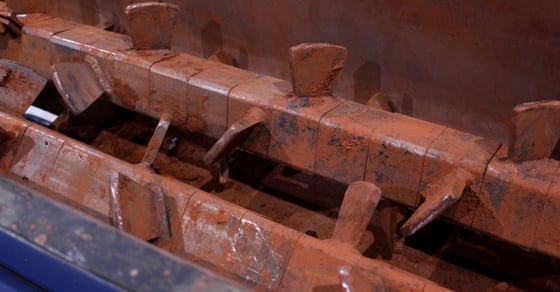The pugmill mixer is an incredibly diverse machine, lending itself to blending, conditioning, mixing, and agglomeration processes throughout a host of industries.
While a well-designed and properly manufactured pugmill mixer is generally reliable, it is not immune to issue; changes in process conditions, the presence of tramp material, wear and tear, and other factors have the potential to create problems with the mixer.
Identifying and resolving problems that arise can be a challenge. As such, we’ve put together the following chart as a general troubleshooting guide covering typical mechanical and process issues encountered with pugmill mixers.
Disclaimer: While this article provides general guidance on troubleshooting pugmill mixers, it is not a comprehensive guide and is not meant to serve as sole guidance on operation and/or maintenance. FEECO does not make any representations or warranties (implied or otherwise) and shall in no event be held liable for any loss of profit or any commercial damage, including but not limited to special, incidental, consequential, or other damage.
| PROBLEM | CAUSE | CORRECTIVE ACTION |
| Material in mixer is too dry at discharge. | -Insufficient amount of wetting agent to material.
-Feed material moisture became dryer. -Inconsistent feed rate. -Not enough retention time in mixer. -Spray openings clogged. | -Increase amount of wetting agent to material.
–Control moisture feed in material. -Control feed rate to be consistent. -Increase material retention time in mixer by rearranging paddles. -Clean openings. |
| Material in mixer is too wet at discharge point. | -Excessive amount of wetting agent added.
-Feed material moisture became dryer. -Inconsistent feed rate. -Too much retention time in mixer. -Spray openings worn, allowing too much wetting agent in, or leaking spray pipes and fittings.
| -Decrease amount of wetting agent to the material.
-Control moisture feed in material. -Decrease material retention time in mixer by rearranging paddles. -Control feed rate to be consistent. -Replace or repair worn spray pipes. |
| Excessive noise during mixer operation. | -Foreign object or loose paddle in the box.
-Gear teeth broken or chipped. | -Check mixer box for foreign objects.
-Tighten paddles. -Replace damaged gear. |
| Material leaking around shafts. | Worn or broken seals. | Tighten or replace worn or broken seals. |
| Paddle drive shafts not rotating when motor is in operation. | Broken coupling. | Install new coupling. |
| Incorrect consistency of material at discharge point. | -Ratio of wetting agent to material is incorrect.
-Paddle mixer arrangement is incorrect for application. | -Experiment by increasing or decreasing amount of wetting agent or material until the desired mix or consistency is achieved.
-Experiment by re-positioning the paddles to increase or decrease material retention time. |
| Large chunks or lumpy material at discharge point of mixer. | -Incorrect amount of wetting agent added.
-Feed material moisture became dryer. -Inconsistent feed rate. -Feed size is too large. -Not enough mixing action. | -Adjust amount of wetting agent added.
-Control moisture in feed material. -Control feed rate to be consistent. -Install a screen or breaker device before material enters the feed opening in the mixer. -Rearrange paddles or install double paddles. |
When to Consider a Pugmill Mixer Process Audit
Quick identification and resolution of issues is an essential aspect of keeping a pugmill mixer operating smoothly and efficiently for its intended service life, as well as maintaining production schedules.
When operators struggle with issues, or when process conditions will or have changed, FEECO recommends enlisting the help of an expert for a process audit to get the process back on track as quickly as possible.
A process audit varies depending on the provider and issue at hand, but in general takes a systematic approach to identifying and resolving the issue, examining original design parameters, observing the process, and troubleshooting with operators, among other things.
FEECO’s extensive background lends additional expertise to a process audit, giving us a birds-eye view of the process and potential points of issue. A FEECO process audit can also lead to a number of other process improvements, such as lower maintenance costs, less downtime, increased production, and more.
Conclusion
While the pugmill mixer generally offers consistently reliable processing, it is not unusual to experience an issue from time to time, be it from changes in process conditions, wear in the mixer, or otherwise. When an issue cannot be readily identified, FEECO recommends conducting a process audit with an expert to quickly resolve the issue.
FEECO is the industry’s leading supplier of custom pugmill mixers. Designing, building, and maintaining these machines has given our Customer Service Team the experience needed to quickly pinpoint and resolve issues to get your operation up and running as quickly as possible and minimize future maintenance costs and downtime. For more information, contact us today!

